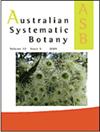Extrafloral nectaries in Leguminosae: phylogenetic distribution, morphological diversity and evolution
IF 1.6
3区 生物学
Q4 EVOLUTIONARY BIOLOGY
引用次数: 20
Abstract
Extrafloral nectaries (EFNs) mediating ecologically important ant–plant protection mutualisms are especially common and unusually diverse in the Leguminosae. We present the first comprehensively curated list of legume genera with EFNs, detailing and illustrating their systematic and phylogenetic distributions, locations on the plant, morphology and anatomy, on the basis of a unified classification of EFN categories and a time-calibrated phylogeny, incorporating 710 of the 768 genera. This new synthesis, the first since Mckey (1989)’s seminal paper, increases the number of genera with EFNs to 153 (20% of legumes), distributed across subfamilies Cercidoideae (1), Detarioideae (19), Caesalpinioideae (87) and Papilionoideae (46). EFNs occur at nine locations, and are most prevalent on vegetative plant parts, especially leaves (74%) and inflorescence axes (26%). Four main categories (with eight subcategories) are recognised and include the following: formless, trichomatic (exposed, hollow), parenchymatic (embedded, pit, flat, elevated) and abscission zone EFNs (non-differentiated, swollen scars). Phylogenetic reconstruction of EFNs suggests independent evolutionary trajectories of different EFN types, with elevated EFNs restricted almost exclusively to Caesalpinioideae (where they underwent spectacular morphological disparification), flat EFNs in Detarioideae, swollen scar EFNs in Papilionoideae, and Cercidoideae is the only subfamily bearing intrastipular EFNs. We discuss the complex evolutionary history of EFNs and highlight future research directions.豆科植物的花外蜜腺:系统发育分布、形态多样性和进化
在豆科植物中,花外蜜腺(efn)介导具有重要生态意义的抗植物保护相互作用尤为普遍且异常多样化。我们提出了第一个综合整理的豆科植物EFN属列表,详细说明了它们的系统和系统发育分布,植物上的位置,形态学和解剖学,在EFN类别的统一分类和时间校准的系统发育的基础上,纳入了768个属中的710个。这是自Mckey(1989)发表开创性论文以来的首次新合成,将具有efn的属数量增加到153个(占豆科植物的20%),分布在尾蕨亚科(1),Detarioideae (19), Caesalpinioideae(87)和凤蝶亚科(46)。efn发生在9个位置,最常见于植物的营养部位,尤其是叶片(74%)和花序轴(26%)。可识别的efn主要分为四类(包括八个亚类),包括以下四类:无形性efn、毛状efn(暴露的、中空的)、实质efn(嵌埋的、坑状的、扁平的、隆起的)和脱落带efn(未分化的、肿胀的疤痕)。EFN的系统发育重建表明,不同类型的EFN具有独立的进化轨迹,升高的EFN几乎只局限于Caesalpinioideae(在那里它们经历了显著的形态分化),扁平的EFN局限于Detarioideae,肿胀疤痕的EFN存在于Papilionoideae, Cercidoideae是唯一具有泡内EFN的亚科。我们讨论了efn复杂的进化历史,并指出了未来的研究方向。
本文章由计算机程序翻译,如有差异,请以英文原文为准。
求助全文
约1分钟内获得全文
求助全文
来源期刊

Australian Systematic Botany
生物-进化生物学
CiteScore
3.10
自引率
12.50%
发文量
12
审稿时长
>12 weeks
期刊介绍:
Australian Systematic Botany is an international journal devoted to the systematics, taxonomy, and related aspects of biogeography and evolution of all algae, fungi and plants, including fossils. Descriptive taxonomic papers should normally constitute a comprehensive treatment of a group. Short papers on individual species and nomenclatural papers must contain significant new information of broader interest to be considered. The prestigious L.A.S. Johnson Review Series is published. Other review articles will also be considered. All papers are peer reviewed.
Australian Systematic Botany is published with the endorsement of the Commonwealth Scientific and Industrial Research Organisation (CSIRO) and the Australian Academy of Science.
 求助内容:
求助内容: 应助结果提醒方式:
应助结果提醒方式:


